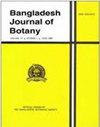水果种植下印度芥菜(Brassica Juncea L.)的养分吸收、质量和肥料生产率受亏缺滴灌调度的影响
IF 0.3
4区 生物学
Q4 PLANT SCIENCES
引用次数: 0
摘要
通过田间试验评估了亏缺灌溉制度(DIS)和不同的农业耕作制度(AHS)对沙壤土下印度芥菜的养分吸收、质量和肥料生产率的影响。结果表明,在不同的灌溉水平中,0.6 IW(灌溉水)/ CPE(累积盘面蒸发量)的比率导致了更高的总氮、磷、钾和硒的吸收量,与 0.4 IW/CPE 和雨水灌溉处理相比仍有显著优势。在不同的 AHS 中,以 Moringa(Moringa oleifera L.)为基础的 AHS 在养分吸收、质量和肥料生产率方面都有显著提高,其次是以 phalsa(Grewia asiatica L.)、karonda(Carissa carandas L.)、印度鹅莓(Phyllanthus emblica L.)和番石榴(Psidium guajava L.)为基础的 AHS。结果表明,印度芥菜可适当采用 0.6 的 IW/CPE 比值进行灌溉,以提高基于辣木的 AHS 的养分吸收率、质量和肥料生产率。孟加拉国植物学杂志52(3):821-827,2023 年(9 月)本文章由计算机程序翻译,如有差异,请以英文原文为准。
Nutrient uptake, quality and fertilizer productivity of indian mustard (Brassica Juncea L.) As influenced by deficit drip irrigation scheduling under fruit plantation
A field experiment was conducted to evaluate effects of deficit irrigation scheduling (DIS) and different Agri-Horti System (AHS) on nutrient uptake, quality and fertilizer productivity of Indian mustard under sandy loam soil. Results revealed that among different levels of irrigation scheduling 0.6 IW (irrigation water)/ Cumulative pan evaporation (CPE) ratio resulted in higher amount of total N, P, K and S uptake which remained significantly superior over 0.4 IW/CPE and rainfed treatments. Among different AHS, Moringa (Moringa oleifera L.) based AHS exhibited significantly higher nutrient uptake, quality and fertilizer productivity followed by phalsa (Grewia asiatica L.), karonda (Carissa carandas L.), Indian gooseberry (Phyllanthus emblica L.) and guava (Psidium guajava L.) based AHS. Results revealed that Indian mustard could be suitably irrigated with 0.6 IW/CPE ratio to achieve higher nutrient uptake, quality and fertilizer productivity under moringa based AHS. Bangladesh J. Bot. 52(3): 821-827, 2023 (September)
求助全文
通过发布文献求助,成功后即可免费获取论文全文。
去求助
来源期刊

Bangladesh Journal of Botany
生物-植物科学
CiteScore
0.80
自引率
0.00%
发文量
77
审稿时长
9 months
期刊介绍:
Bangladesh in situated on the north of Bay of Bengal. Climatically it is a humid subtropical country. Most of the land is deltaic plain of two great rivers, the Ganges and the Bhrammaputra and it tributaries. The country has rich diversity of plants. Main crops cultivated are Rice, Jute, Wheat, Maize, Sugarcane, Mustard and different kinds of Lentils. There are a good number of Public and Private Universities and Plant Research Establishments.
Bangladesh Journal of Botany is the official organ of the Bangladesh Botanical Society established in 1972. Since 1972 Bangladesh Journal of Botany is being published regularly. Two issues of the Journal are published, one in June and another in December.
Scientific papers (Full paper and short communication) on any field of Plant Sciences from anywhere in the World are considered for publication in Bangladesh Journal of Botany.
 求助内容:
求助内容: 应助结果提醒方式:
应助结果提醒方式:


